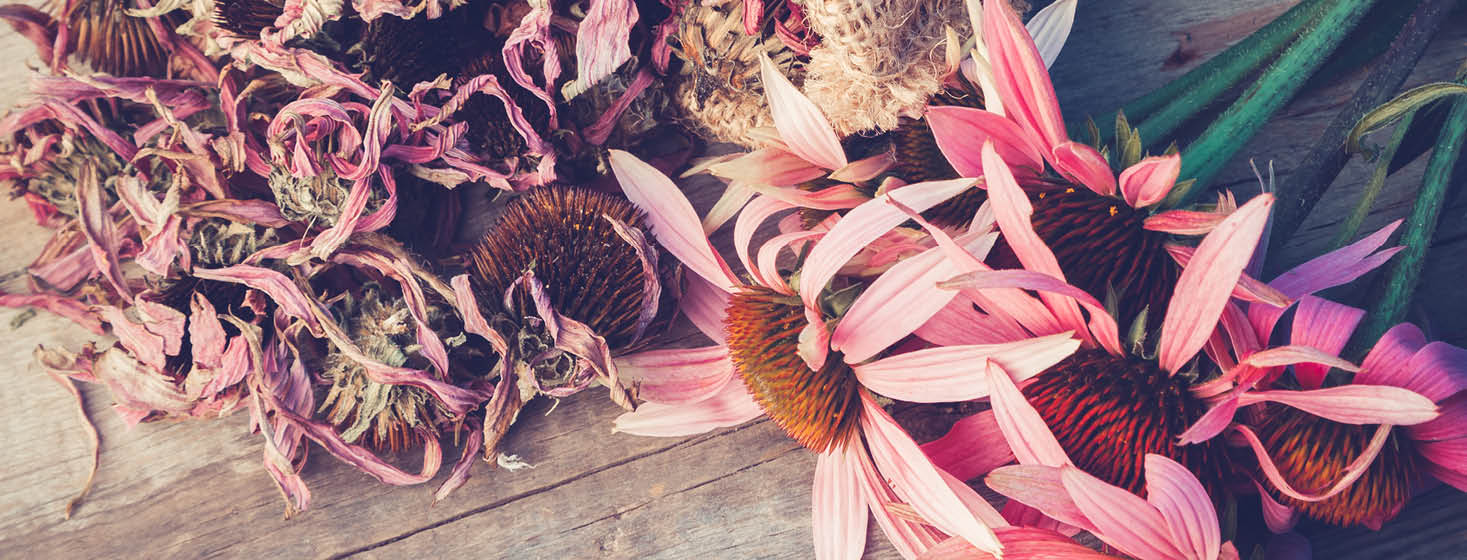
Echinacea species, commonly known as Purple Coneflower, have a long history of medicinal use and originates from North America. Echinacea is often identified by its giant purple daisy flower with a distinctive orange ‘cone’ centre that looks a bit like a baby hedgehog. In fact, this resemblance is the origin of the plant’s name which is derived from the greek word for hedgehog, ‘ekhinos’,
Many North American Indian tribes used Echinacea root both topically and internally for a wide range of infectious and inflammatory conditions. Externally, it was applied for burns, and snake bites, the root was taken internally for toothaches, colds, sore throats, tonsillitis, measles, mumps and smallpox. The traditional uses of this herb have been supported by clinical studies which have shown it possesses a unique immune stimulating action.
These clinical trials and extensive clinical experience highlight the importance of two key factors when taking Echinacea for immunity – the first is the quality of the product you’re taking, and the second is that adequate dosage is taken to achieve the benefits of Echinacea.
Quality
Despite its spectacular display of beauty with its stunning purple flowers, in terms of medicine, the real goodies in Echinacea are below the earth in the roots of the plant. Echinacea root is the part of the plant which was traditionally used by North American Indians, and the dried root has the highest concentration of the active compounds, known as alkylamides. The alkylamides present in Echinacea root activate your immune system, and their presence can be detected by your tongue. You can tell the quality of your Echinacea preparation by how much your tongue ‘tingles’ or buzzes when you take it.
In addition, there is evidence of a higher risk of allergic reactions from preparations made from the aerial parts of the plant (flower, leaves & stems) so the root is a safer and more effective option.
Dosage
The effectiveness of Echinacea for prevention and treatment of colds and flu is dose related. Evidence from clinical trials suggests the preventative dosage for Echinacea purpurea is equivalent of 1000-2000mg dried root per day. Clinical experience suggests the treatment dosage during an acute infection should be 2–4 times greater than the preventative dose, ie 2000-8000mg dried root per day. The timing of the dosage has also been shown to be important when it comes to keeping healthy in winter. Research has shown that Echinacea is best taken at the first sign of illness – right when you get that tickle in the throat. When taken early enough and in high enough doses it may help with those nasty winter ills and chills!
Kiwiherb produce a range of Echinacea products suitable for the whole family. Buy them now from our secure online shop.
We'd Love Your Feedback
Have you tried an Echinacea product? If yes, what was it and did you experience the benefits you were hoping for?
References
Rasmussen PL, Phytonews 4, ISSN 1175-0251, published by Phytomed Medicinal Herbs Ltd, Auckland, New Zealand, Aug 1999.
Rasmussen PL, Phytonews 15, ISSN 1175-0251, published by Phytomed Medicinal Herbs Ltd, Auckland, New Zealand, March 2003.
Rasmussen PL, Phytonews 18, ISSN 1175-0251, published by Phytomed Medicinal Herbs Ltd, Auckland, New Zealand, Apr 2004.
Rasmussen PL, Phytonews 23 ISSN 1175-0251, published by Phytomed Medicinal Herbs Ltd, Auckland, New Zealand, Aug 2005.
Shah SA et al, Lancet Infectious Diseases, 7(7): 473-480, July 2007.
Melchart D et al, Cochrane Database Sys Rev 2000;2:CD000530.
Linde K et al, Cochrane Database Syst Rev 2006:1:CD000530.

